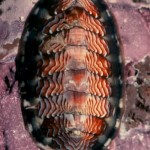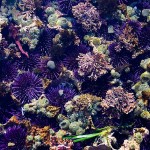The color pink abounds in the tidepools. Much of it is coralline algae, a type of red algae that flourishes in marine environments around the world.
Coralline algae gets its name and rock-hard texture from calcareous deposits in its cells. Having this hard shell makes it an unappetizing food for most grazers in the tidepools, but sea urchins and some limpets and chitons feed on it.
There are two basic forms of coralline algae.
Encrusting coralline algae looks like thick pink paint that’s been applied to rocks, shells, and other hard surfaces. Encrusting coralline algae can be several millimeters thick and either smooth or bumpy. Growths of it can cover several square feet and often it coats entire rocks and shells. It even grows on the shells of living animals!
Branching coralline algae are articulated, branching like flexible trees or bushes standing several inches high in the tidepools. Some tinier ones grow as ephiphytes on blades of sea grass or other types of algae or on mollusks or crustaceans.


